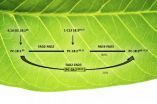(Press-News.org) ST. LOUIS – Air and surface sampling techniques currently used by the US government are effective in fighting bioterrorism and potentially saving lives, a Saint Louis University researcher finds.
Results published in Biosecurity and Bioterrorism by Alexander Garza, M.D., MPH, former chief medical officer at the Department of Homeland Security and a team of researchers from Los Alamos National Lab reviewed the data from a series of experiments simulating a bioterrorism attack against the Pentagon. Garza is now the associate dean for public health practice and associate professor of epidemiology at Saint Louis University College for Public Health and Social Justice.
In 2005 and 2009, the Pentagon Force Protection Agency (PFPA) in order to simulate a deliberate attack, staged the release of a harmless bacteria that is biological similar to Bacillus anthracis, the bacteria that causes the disease anthrax. They then evaluated the local response procedures to such an attack. In conjunction with this exercise, the Department of Homeland Security ran its own experiments to test the efficacy of an air and surface sampling system known as BioWatch in detecting these biological agents in the environment.
In the experiments, multiple kilograms of benign material were released, which included a small portion of the anthrax simulant. The team collected samples of the air through several portable sampling units and had them analyzed at specialized laboratories.
"We were able to detect the biological organisms released several kilometers from where the agent was originally released," Garza said. "We were not entirely surprised by the results. Since all of the modeling that had been done to date showed that air samplers should be able to detect these types of attack, what was missing was empirical evidence showing that these systems would work in real world conditions. We now have that evidence."
"The traditional way to detect that someone has been exposed to a biological agent is to wait until a person becomes symptomatic and then hope that the clinician is able to correctly diagnose the patient," Garza said, "which is exactly what happened during the anthrax attacks in 2001."
Garza points out the problem with this approach is that once people become sick they are likely to die, which can potentially lead to significant casualties in a large-scale attack.
"This experiment confirmed that a biological attack could be detected earlier using air sampling which means public health would have more time to respond."
Air sampling has been readily accepted for similar uses such as measuring for particulate matter, however using it to detect bacteria in biological terrorism was a new concept instituted after the 9/11 attacks. This type of sampling is now part of a sophisticated system used by the Department of Homeland Security and the Department of Defense.
However, in order for the system to work more efficiently in the real world, Garza believes the detection cycle, which currently takes between 12-36 hours, would need to produce results in a shorter time frame.
"The current process is labor-intensive and time-consuming. It takes a lot of manual labor and time to do the laboratory work," he said.
Since it usually takes at least a couple of days for a person to show symptoms from a biological attack, Garza emphasizes the importance of an improved detecting system that would give officials more time to investigate and ramp up a medical response plan to save lives.
"If we can detect a dangerous pathogen in the environment at an earlier stage, we can quickly start planning the response procedure for it like distributing antibiotics," Garza said. "The sooner we pick up clues, the sooner we can act and save more lives."
INFORMATION:
The Saint Louis University College for Public Health and Social Justice is the only academic unit of its kind among the nearly 250 Catholic institutions of higher education in the United States.
With a focus on finding innovative and collaborative solutions for complex global health problems, the College offers nationally recognized programs in global public health, social work, health management and health policy, epidemiology, biostatistics, environmental and occupational health, behavioral science and health education, emergency management, biosecurity and disaster preparedness, and criminology and criminal justice.
Study validates air sampling techniques to fight bioterrorism
Former Department of Homeland Security medical officer leads experiments to test early detection for bio threats
2014-05-09
ELSE PRESS RELEASES FROM THIS DATE:
New species of metal-eating plant discovered in the Philippines
2014-05-09
Scientists from the University of the Philippines, Los Baños have discovered a new plant species with an unusual lifestyle — it eats nickel for a living — accumulating up to 18,000 ppm of the metal in its leaves without itself being poisoned, says Professor Edwino Fernando, lead author of the report. Such an amount is a hundred to a thousand times higher than in most other plants. The study was published in the open access journal PhytoKeys.
The new species is called Rinorea niccolifera, reflecting its ability to absorb nickel in very high amounts. Nickel hyperaccumulation ...
Plants' oil-desaturating enzymes pair up to channel metabolites
2014-05-09
UPTON, NY-Plant scientists at the U.S. Department of Energy's Brookhaven National Laboratory have found that certain enzymes responsible for desaturating fatty acids, the building blocks of oils, can link up to efficiently pass intermediate products from one enzyme to another. "Engineering these enzyme interactions to channel metabolites along desired metabolic pathways could be a new approach for tailoring plants to produce useful products," said Brookhaven biochemist John Shanklin, lead author on a paper reporting the results in the Journal of Biological Chemistry.
Getting ...
Leadless pacemaker showing promising results after 1 year
2014-05-09
Vivek Reddy, MD, Director of Arrhythmia Services for The Mount Sinai Hospital, reported his promising12-month follow-up data showing the world's first leadless pacemaker is demonstrating overall device performance comparable to conventional pacemakers. Dr. Reddy presented the one-year LEADLESS study data findings during his late-breaking clinical trial presentation on May 9 at Heart Rhythm 2014, the Heart Rhythm Society's 35th Annual Scientific Sessions in San Francisco, CA.
The LEADLESS study's long-term follow-up has evaluated 32 patients with a slowed heartbeat, bradycardia, ...
Scientists decode epigenetic mechanisms distinguishing stem cell function and blood cancer
2014-05-09
Researchers at Dartmouth's Norris Cotton Cancer Center have published results from a study in Cell Reports that discovers a new mechanism that distinguishes normal blood stem cells from blood cancers.
"These findings constitute a significant advance toward the goal of killing leukemia cells without harming the body's normal blood stem cells which are often damaged by chemotherapy," said Patricia Ernst, PhD, co-director of the Cancer Mechanisms Program of the Norris Cotton Cancer Center and an associate professor in Genetics at the Geisel School of Medicine.
The study ...
Study identifies mechanism by which intestinal enzyme maintains microbial balance
2014-05-09
Massachusetts General Hospital (MGH) investigators have identified the mechanism by which an enzyme produced in the intestinal lining helps to maintain a healthy population of gastrointestinal microbes. In their report in American Journal of Physiology – Gastrointestinal and Liver Physiology, the research team describes finding that intestinal alkaline phosphatase (IAP) promotes the growth of beneficial bacteria by blocking the growth-inhibiting action of adenosine triphosphate (ATP) – an action first described in this paper – within the intestine.
"We found that ATP ...
NASA sees system 90E just after earthquake hit Mexico's Guerrero State
2014-05-09
VIDEO:
This movie of imagery from NOAA's GOES-West satellite from May 7 at 14:15 UTC to May 9 at 14:15 UTC shows System 90E's progression and movement on land in southwestern...
Click here for more information.
As the dissipating tropical low pressure system known as System 90E continued rain on Guerrero State in southern Mexico, the U.S. Geological Survey reported a 6.4 magnitude earthquake occurred there on Thursday, May 8 around noon local time (1 p.m. EDT). NASA's Aqua satellite ...
Bioprinting a 3D liver-like device to detoxify the blood
2014-05-09
Nanoengineers at the University of California, San Diego have developed a 3D-printed device inspired by the liver to remove dangerous toxins from the blood. The device, which is designed to be used outside the body -- much like dialysis – uses nanoparticles to trap pore-forming toxins that can damage cellular membranes and are a key factor in illnesses that result from animal bites and stings, and bacterial infections. Their findings were published May 8 in the journal Nature Communications.
Nanoparticles have already been shown to be effective at neutralizing pore-forming ...
Rotational X-ray tracking uncovers hidden motion at the nanoscale
2014-05-09
Over the past two decades or so, there has been increasing interest and development in
measuring slow dynamics in disordered systems at the nanoscale, brought about in part from a demand for advancements in the food and consumer products industries.
Some of the techniques that have been developed over recent years to study the dynamic properties of these materials include X-ray photon correlation spectroscopy (XPCS) and speckle visibility spectroscopy (SVS). Both of these techniques however suffer from some fundamental limitations ranging from the use of only specialized ...
Study predicts adult obesity prevalence in almost all European countries by 2030
2014-05-09
Amsterdam, 9 May. Rates of obesity and overweight in both male and females are projected to increase in almost all countries of Europe by 2030, according to a statistical modelling study. However, the forecast rates vary throughout the 53 Euro-region countries, with projected male obesity levels ranging from 15% in the Netherlands and Belgium, to 47% in Ireland. The highest obesity prevalence in females was projected in Ireland (47%), and the lowest in Romania (10%).
The study, from investigators which included the WHO Regional Office for Europe, was presented at the ...
Colonization of Brazil by the cattle egret
2014-05-09
In recent years the cattle egret (Bubulcus ibis) has colonized American continent. Invasive species are a worldwide problem and studies are devoted to assess the damage they cause to local species populations. Thus, the process of colonization of a new territory that has continental dimensions such as Brazil offers an excellent opportunity to examine how non-native species disperse, adapt and survive. A new study of the colonization patterns of the cattle egret in Brazil, published in the open access journal NeoBiota, offers a new take on the study of alien species.
The ...
LAST 30 PRESS RELEASES:
Tracing the quick synthesis of an industrially important catalyst
New software sheds light on cancer’s hidden genetic networks
UT Health San Antonio awarded $3 million in CPRIT grants to bolster cancer research and prevention efforts in South Texas
Third symposium spotlights global challenge of new contaminants in China’s fight against pollution
From straw to soil harmony: International team reveals how biochar supercharges carbon-smart farming
Myeloma: How AI is redrawing the map of cancer care
Manhattan E. Charurat, Ph.D., MHS invested as the Homer and Martha Gudelsky Distinguished Professor in Medicine at the University of Maryland School of Medicine
Insilico Medicine’s Pharma.AI Q4 Winter Launch Recap: Revolutionizing drug discovery with cutting-edge AI innovations, accelerating the path to pharmaceutical superintelligence
Nanoplastics have diet-dependent impacts on digestive system health
Brain neuron death occurs throughout life and increases with age, a natural human protein drug may halt neuron death in Alzheimer’s disease
SPIE and CLP announce the recipients of the 2025 Advanced Photonics Young Innovator Award
Lessons from the Caldor Fire’s Christmas Valley ‘Miracle’
Ant societies rose by trading individual protection for collective power
Research reveals how ancient viral DNA shapes early embryonic development
A molecular gatekeeper that controls protein synthesis
New ‘cloaking device’ concept to shield sensitive tech from magnetic fields
Researchers show impact of mountain building and climate change on alpine biodiversity
Study models the transition from Neanderthals to modern humans in Europe
University of Phoenix College of Doctoral Studies releases white paper on AI-driven skilling to reduce burnout and restore worker autonomy
AIs fail at the game of visual “telephone”
The levers for a sustainable food system
Potential changes in US homelessness by ending federal support for housing first programs
Vulnerability of large language models to prompt injection when providing medical advice
Researchers develop new system for high-energy-density, long-life, multi-electron transfer bromine-based flow batteries
Ending federal support for housing first programs could increase U.S. homelessness by 5% in one year, new JAMA study finds
New research uncovers molecular ‘safety switch’ shielding cancers from immune attack
Bacteria resisting viral infection can still sink carbon to ocean floor
Younger biological age may increase depression risk in older women during COVID-19
Bharat Innovates 2026 National Basecamp Showcases India’s Most Promising Deep-Tech Ventures
Here’s what determines whether your income level rises or falls
[Press-News.org] Study validates air sampling techniques to fight bioterrorismFormer Department of Homeland Security medical officer leads experiments to test early detection for bio threats






